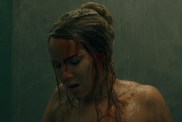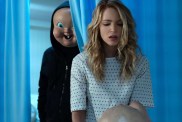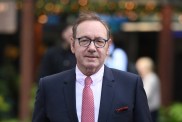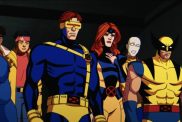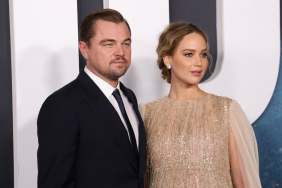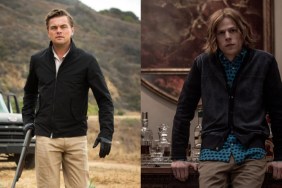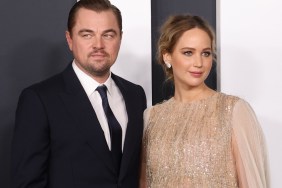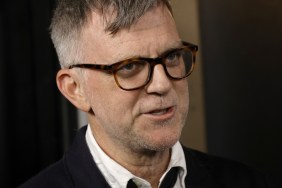Imagine striving for something for years, building a life with the sole purpose of reclaiming that thing you lost, only to finally get it and still be too consumed by the pursuit to appreciate it. So it goes for Leonardo DiCaprio’s Jay Gatsby in The Great Gatsby.
Based on the iconic F. Scott Fitzgerald book, Baz Luhrmann’s tale is told from the perspective of Tobey Maguire’s Nick Carraway, a Yale grad settling down on Long Island to take a job as a bonds salesman in New York City. Nick finds a tiny but cozy cottage right across the bay from his old college buddy Tom Buchanan (Joel Edgerton) and his wife and Nick’s cousin, Daisy (Carey Mulligan). Even though Nick doesn’t exactly fit in with the ritzy lifestyle, soon enough he’s guzzling booze with Tom, his mistress Myrtle (Isla Fisher) and their friends, and attending the most lavish parties in town, which happen to take place right next door to his very own cottage at the elusive Jay Gatsby’s mansion.
The Great Gatsby
While discussing the character at the Great Gatsby press conference in New York City, held appropriately at the Plaza Hotel, DiCaprio highlighted one of Gatsby’s more relatable qualities, his ambition. “He’s a character that has created himself according to his own imagination and dreams, and lifted himself from his own bootstraps as a poor youth in the Midwest, and created this image that is ‘the Great Gatsby’ and it’s a truly American story in that regard.” He added, “I think we can all relate to that dreamer in Gatsby.”
However, a quest that once defined Gatsby as a “hopeless romantic” for a young DiCaprio when he first read the book in junior high, now delineates him as an empty man. “After this great caravansary that he’s created known as Gatsby’s Castle in order to lure Daisy in, Nick notices that he’s holding her yet he’s still staring out at the green light. He’s finally got her in his arms, but he’s still searching for this thing that he thinks is gonna complete him.” DiCaprio goes on to point out, “I was struck by the sadness in him for the first time and I looked at him completely different. I looked at him as somebody that was very hollow and searching for some sort of meaning, and Nick is the only one that truly sees what’s going on in reality.”
The Nick and Gatsby Connection
At first, Gatsby identifies Nick as a means to Daisy, but before long, the two develop a true and trusting friendship, something Gatsby’s never managed to achieve despite hosting packed parties.
Maguire noted, “Leo and I have a very kind of trusting and close friendship so I think that just the kind of comfortable, open dialogue that we had in terms of the working process contributed to what we did.”
DiCaprio added, “We’re always extremely honest with each other and to me, I don’t know if this project would have happened unless we had that sort of relationship because it needed that. We needed those checks and balances, and we needed to have a contract with each other to continually be honest with one another.”
Luhrmann jumped in. “Can I add a tiny little thing to that? Because I think these two gentlemen cannot say this, but it’s a little anecdote from our first day of shooting.” It was the flower scene, the scene during which Gatsby prepares an extravagant reunion for Daisy with Nick’s help. Luhrmann recalled, “There was written dialogue in the scene,” but between the nerves of adapting such a beloved book, the pressure of beginning a challenging shoot, and all of those flowers, Luhrmann buckled, called action and gave DiCaprio and Maguire his direction, “You’re just waiting for Daisy, but let’s not do the scene. Let’s just improvise.”
He recollected their chat, “I think Leonardo says, ‘Do you think it’s the flowers are lovely aren’t they?’ Tobey goes, ‘Yes, yes.’ ‘Do you think do you think it’s too much?’ And Tobey pauses and he goes, ‘No.’ Nick pauses and looks around, he goes, ‘I think it’s what you want.'” Luhrmann noted, “That moment I think is one of the purest and most connected moments in the film and it completely came from I think a depth of relationship that existed before we began rehearsals. And it was funny because it was the first thing we ever shot and for me, it’s one of the most truthful and wonderful moments in the film. From a director’s point of view, there was a grand value in the depth of their friendship.”

It’s All About Daisy
And then there’s the core of the film, the thing the entire tale essentially revolves around, Daisy. Even as the centerpiece of Gatsby’s mission, Mulligan was tasked with a tricky challenge, as from the outsider’s perspective, Daisy isn’t a particularly determined character.
Mulligan explained, “She’s very easily led and she’s drawn to the strongest force in the room. I think she’s very reactive, I just don’t think she acts very well. I don’t think she makes decisions for herself. There were so many turns in her personality and so often she doesn’t say what she means and so often she says things for effect, and that’s really fun to play.”
Whereas some will judge Daisy for this patsy status and also for flat-out marrying for money, producer/production designer/costume designer and Mrs. Luhrmann, Catherine Martin pointed out, “I think there’s an incredibly telling scene when you realize that Daisy is a product of her era and a product of her sociological milieu when she says outside to Nick, ‘You know, when my daughter was born, I just hoped she’d be a fool because that’s the best thing a girl can be, a beautiful little fool.’ And in that moment you realize that Daisy isn’t a fool, but she is trapped within her own circumstances and I think [Carey] creates an incredibly attractive character and you understand why Gatsby loves her, and you also understand her flaws.”
Mulligan further elaborated, “When I defend Daisy I always say that she came from a family that would have encouraged and expected her to marry for money and had she done anything else, it would have been scandalous. So it’s hardly weakness of character at that point.”
And it wasn’t easy achieving that balance and offering that level of insight. Not only was Mulligan working off of Fitzgerald’s novel, but a stack of books by Zelda Fitzgerald assigned by Luhrmann as well as the love letters exchanged between Fitzgerald and his muse, Ginevra King. Mulligan explained, “Because there are holes in Daisy’s character, you meet her at the beginning of the story and then she disappears for a long time and often she’s not saying what she means and often she’s sort of acting quite erratically, there was quite a lot to fill in just to play her consistently.”
Luhrmann narrowed down the result of Mulligan’s studies by highlighting a single line of dialogue. “There’s a bit of a moment in which she goes, ‘I wish I had spent all those days with you.’ These are lines from Zelda Fitzgerald’s letters to Scott in that dialogue. Some of the lines that Carey speaks are from letters from Ginevra King that she found in the library.”

Long Island in Australia
As you can likely tell from The Great Gatsby‘s trailers–and as you’ll very well see in the final feature–no matter how hard the cast worked, the support of a convincing set was vital to the film’s success.
When asked if DiCaprio had the opportunity to take a method approach to his role living in Gatsby’s mansion, Luhrmann joked, “I used to come in in the morning and say, ‘Please wake Mr. Gatsby. Mr. Luhrmann is ready to give him his close-up.’ And then a dozen servants would tap on his door and he’d come down in a dressing gown and say, ‘I’m ready.'”
In all seriousness, Luhrmann recalled, “Australia became an absolute part of the equation economically.”
DiCaprio also added, “I think what was amazing about shooting in Australia and recreating all the sets and this entire world was the incredible enthusiasm and the work ethic of all the people there. I think it infused us with this great energy.”
And it’s a good thing everyone got that energy boost, because they were up against a production challenge that only Mother Nature could resolve.
Luhrmann explained, “There was this one mountain where in the 1850s the English people went because it was so hot and they were wearing obviously crinolines, very hot clothes, and they went up and they planted trees, deciduous trees, which looked a bit like the east coast here in England.”
Considering the rest of the country consisted of gum trees (eucalyptus), Luhrmann decided that that was the spot necessary to believably recreate Long Island. The trouble was, “We went up there, it rained, we got rained out once, we got rained out twice, we got rained out three times, four times, five times. Eventually, I think we made Nick’s little tiny cottage in four, five different locations in six ways and then we shut down, we went away, we still hadn’t finished, we came back in February when the sun came out and it rained again!”
As for the mansion in particular, Luhrmann pointed out, “The exterior of the mansion is what used to be called the Cardinal’s Palace and I went to a Catholic boy’s school there for a short time. It’s connected to the back of it, but it was grand enough to look like this kind of, as S. Scott Fitzgerald describes it, it looked like a Normandy castle.” He added, “Gatsby’s mansion was a fantasia. We called it the Disney for adults castle.”

The Orgy Scene
Another very adult element of the film is something Luhrmann dubbed “The Orgy Scene.” After getting all of the traditional coverage of the party with Tom, Nick, and Myrtle amongst others, Luhrmann recalled thinking about how Fitzgerald’s description of the party gets very abstract and even blurry in a way, and Luhrmann wanted to achieve that, too. With about 20 minutes to go until wrap, Luhrmann recalled, “I ran around and had a little chat to everyone, we all sort of had little whispers and I said, ‘We’ve got 20 minutes left. Let’s turn all the cameras on and let’s go for it.'” Luhrmann elaborated, “There was a bit of pillow fighting and some photographs being taken, and right in the middle of the jazz, I just turned up very very loudly a track called ‘N.I.P.,’ which was a Jay-Z track, which was mixed with jazz at the same time. He made this special track. And things took off. And the cameras rolled for 20 minutes, and there was a moment, and you see it in the film, where a very expensive lamp smashes right in the middle of the movie and my first assistant said, ‘Baz, Baz, we’ve gotta shut it down,’ because by then it was crazy mayhem of levels you can’t imagine.”
What Might Fitzgerald Think?
Some of the biggest names in Hollywood, Jay-Z tracks and outrageous Disney-esque parties, but now the question is, “How might F. Scott Fitzgerald feel about all of it?”
Producer Lucy Fisher explained, “When he died, there were 4,000 copies of the book in print. There’s great correspondence between him and his editor Maxwell Perkins, if anybody’s interested, in which Fitzgerald is pouring his heart out and writing for money and just hoping that the book will sell.”
Luhrmann jumped in, “When Fitzgerald was about to die he was going into shops buying copies of his own book, The Great Gatsby, just so there would be a few sales registered at the publishing company.”
Luhrmann also admitted, “I don’t know what he would think about this film,” but noted, “The fact that he’s the number one selling book in America today, I know he’d feel pretty good about that, so that’s probably the only thing that I could contribute is that the fact that the book has endured.”
You can judge for yourself whether Luhrmann did Fitzgerald’s work justice when The Great Gatsby arrives in theaters on May 10. You can also read our earlier exclusive interview with Baz Luhrmann by clicking here.
